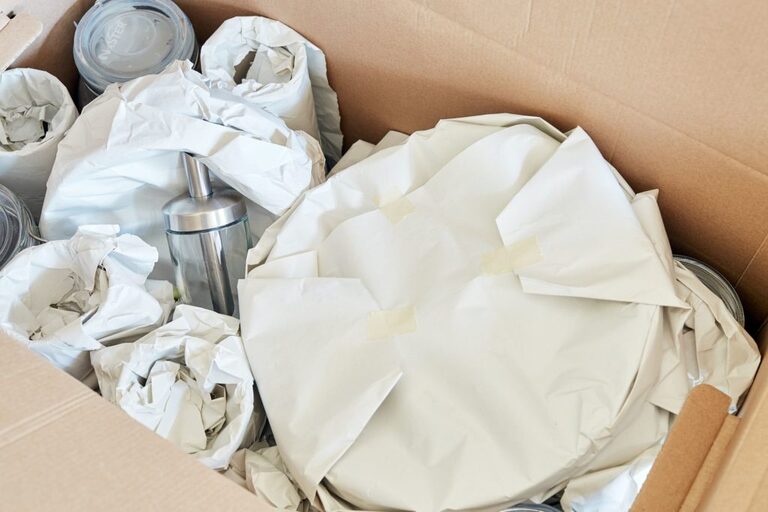Deciding how to pack clothing for a move is not an easy task; you spend so much of your time packing up your furniture, trying to figure out what to do with your big items, and wrapping your fragile items so they can safely travel to your new home, that it is all too often that you lose track of the little things – namely your clothing – and run last minute to throw them in a bag (or bags)!
While that may not be the worst way to pack your clothing, there is a very good chance you will waste a lot of space and time (when you unpack), and your clothes will be a wrinkly, torn-up mess. Instead of putting yourself through that hassle, why not make the whole moving process easier on yourself later on by following our top tips for how to pack clothes for moving?
Tips for Packing Clothes For Moving

Step 1: Declutter your wardrobe
Before you begin packing your clothing for the move, you will first need to decide what you will take with you. Moving house is a perfect opportunity to go through your clothing with a fine-tooth comb! Differentiate between ‘must-haves’ and ‘don’t needs’. Anything you don’t need can be sent to charity or sold on eBay. After all, why bother packing, moving, and unpacking clothing that you will never wear again? You could also keep some old clothing for packing material – old t-shirts, sweaters, and skirts are all great to save for packing fragile items like cups and glasses.
If you’re looking for some more tips, check out our How to Declutter Before Moving House Checklist.
Step 2: Wash and dry your clothes well
The simplest way to pack clothing for moving to another location is to make sure all your clothing is washed and dried. That way, you are ensuring that everything you pack is clean and fresh. Moreover, if you do not unpack them quickly after the move, you could end up with stains and odors that may prove to be difficult to remove on clothing that was already dirty.
Step 3: Organise your clothing
Once you have your clothing (washed and dried) all together, it will be helpful to organize your clothing into categories to prepare for packing them to move. Organizing your clothing will help you to unpack very quickly and easily.
You can organise your clothing by size, season, purpose, material, usage, or anything else that works best for you.
Once you decide on the method to categorise your clothes, make piles based on your categorization method.
Step 4: Use Sturdy Clothing Boxes
The best moving boxes are specialty boxes made for packing clothing. A professional removalist company should have moving boxes that allow you to load and move your entire closet when still on coat hangers, ensuring that your clothes arrive clean and free from wrinkles and ready to hang immediately when you arrive at your new home. The type of moving boxes they should be able to offer you boxes in different sizes to fit all your clothing, rolled or folded up, inside.
Do not pack or move your clothing in plastic bags because they can trap moisture, and over time, it will seep into your clothes and make them smell bad or even molding.
Hot Tip: As much as you may be tempted, never pack clothes in the drawers. This will just make your drawers heavier than they need to be, making them hard to move, and if they fall over, the chances of breaking an entire drawer will be higher.
Step 5: Roll or vacuum seal clothing to maximise space
If you’ve ever been in a backpacker’s hostel or gone hiking, you know that travellers have a knack for packing their clothing for living on the move. Backpackers and hikers roll up their clothes before putting them in their packs. Why? Rolling up clothes takes up less space and is less wrinkle-prone than folding. If you roll clothes instead of folding, you will be amazed at how much you can fit into your moving clothing box.
You can also vacuum pack clothing to save space in moving boxes. Just keep in mind that after a while, your clothing vacuum-sealed will ruin the natural fibres. Even with all the good intentions of moving to a new home, vacuum sealing clothing is a good way to move short-term, but not preferred for long-term storage.
Step 6: Label the boxes and the category
Once you’ve packed your clothing and are ready to relocate, label the boxes with a category. Depending on the categories you’ve chosen and their description, you may want to provide a detailed description of them. For example, if you’ve chosen to roll with the ‘Seasons’ category, your label may look like…
Step 7: Load high-priority items into the moving truck
Loading high-priority items into your moving logistics vehicle includes items other than clothing. Loading the high-priority items last ensures you will access them first, considerably simplifying unpacking at your new residence.
For instance, if you’ve decided to use the ‘Seasons’ categorising system and you’re moving during the summer, be sure to load all the ‘Summer’ boxes last and all the ‘Winter’ boxes first. This will allow you to access the clothes that you need to wear as soon as and as easily as possible. By this time, all of your hard work in categorising will pay off.
Wrapping Up
Follow this step-by-step process and you’ll be an expert in packing clothing for a move. It’s about putting systems into place to create smoother sailing on moving day and lessen the anxiety too many people face on their move day.
FAQs
Q: Does rolling your clothes make your suitcase heavier?
A: Rolling clothes won’t add weight to your luggage – unless you bring more, because of all that extra space you saved! So watch it on overpacking! Instead of rolling clothes to save space, roll them so that you can use a carry-on bag, which will help your bag weigh much less.
Q: Is it better to fold or hang clothes?
A: Formal and lightweight fabric clothing items should be placed on hangers, while heavier and informal clothing items can be folded. Folding clothing is generally more space-efficient than hanging it. That said, folding garments does not work for everything. For example, if you were to fold your trench coats, you would ruin them!
Q: Should I pack my clothes in boxes or bags?
A: It usually makes sense to use a combination of both. Wardrobe boxes with a suspended bar for hanging clothing are ideal for hanging items, while large bags or boxes work well for folded clothing. Fragile clothing could also benefit from garment bags.




